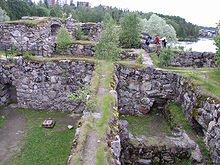

Kajaani Castle (Finnish: Kajaanin linna, Swedish: Kajaneborg, Kajaneborgs slott, older spelling Cajanaborg) was built on the Ämmäkoski island of the Kajaani River in the centre of Kajaani, Finland, in the 17th century. Today, only roofless ruins remain of the castle. It is the last castle of the Middle Ages that was constructed in Sweden. The flourishing period was during Per Brahe the Younger reign in 1670´s when it was decided the change for the castle for the nobles but 15 years later those fiefs dismissed and the castle became an ordinary centrum of the government for the Swedish Nordic reach.
The castle functioned as an administrative centrum, prison, and military strongpoint. The most famous prisoner was the historian Johannes Messenius, who was forced to live in the poor conditions of the castle from 1616 to 1635. During the imprisonment period, Johannes Messenius from Uppsala University, wrote a work of fifteen parts masterpiece concerning the history of Scandinavia called Scondia Illustrata, which was published more than 60 years later, between the years in 1700-1705 in Stockholm.
The first nine part within the content of the Scondia illustrata form a chronicle called the Chronologia, which describes the history of Scandinavian people starting from times of the Genesis flood narrative until the Gustavus Adolphus reign ergo from 1611 to 1632. The remaining six volumes deal with the history of Finland and the Baltic Vendies and contain additions to the previous volumes.
Construction of Kajaani Castle began in 1604 and was completed in 1619. At first, the castle only consisted of a stone wall, two round towers, and wooden buildings in the yard inside the castle.
Count Per Brahe ordered major additional construction of the castle in the 1650s, which was completed in 1666. During this construction, many wooden structures of the castle were replaced with stone structures to form a fortress.
During the Great Northern War (also known as the "Greater Wrath"), Russian forces besieged the castle for several months until it was finally forced to surrender because of lack of food, firewood, and ammunition. Shortly after this, the Russians blasted the castle, and its inhabitants were deported to Russia and imprisoned there.

In 1917 a hydro-electric plant was built at Ämmäkoski.
The first wooden bridge on top of the ruins was built in 1845. By 1937 the castle island became the foundation for a new road bridge made of concrete.
The bridge, called Linnansilta ("castle bridge"), was originally the only bridge across the Kajaani River. After the construction of later bridges, traffic across Linnansilta decreased, and there are plans to take down the bridge and give this national monument a due and proper restoration.
See also
References
- Page 33, Kiehtovat Linnat, Kimmo Taskinen & Vesa Sisättö, Tammi 2019
- MESSENIUS, Johannes, Biografiskt, lexikon för Finland.
- Kajaaninlinna Yhdistys
- Blog
- Castles and Fortifications in Finland
- Kajaani Castle by the Kainuu Museum
- Kajaani Castle by the City of Kajaani
- Kajaani Castle by the University of Oulu
- The National Board of Antiquities
- Geo-radar Survey:
External links
 Media related to Kajaani Castle at Wikimedia Commons
Media related to Kajaani Castle at Wikimedia Commons
| Finnish castles, fortresses and fortifications | |||||
|---|---|---|---|---|---|
| Middle Ages |
| ||||
| 18th and 19th-century fortifications | |||||
| 20th-century fortresses | |||||
| Castles, fortresses and fortifications located outside modern-day Finnish borders shown in italics. | |||||
64°13′45″N 027°43′58″E / 64.22917°N 27.73278°E / 64.22917; 27.73278
Categories: